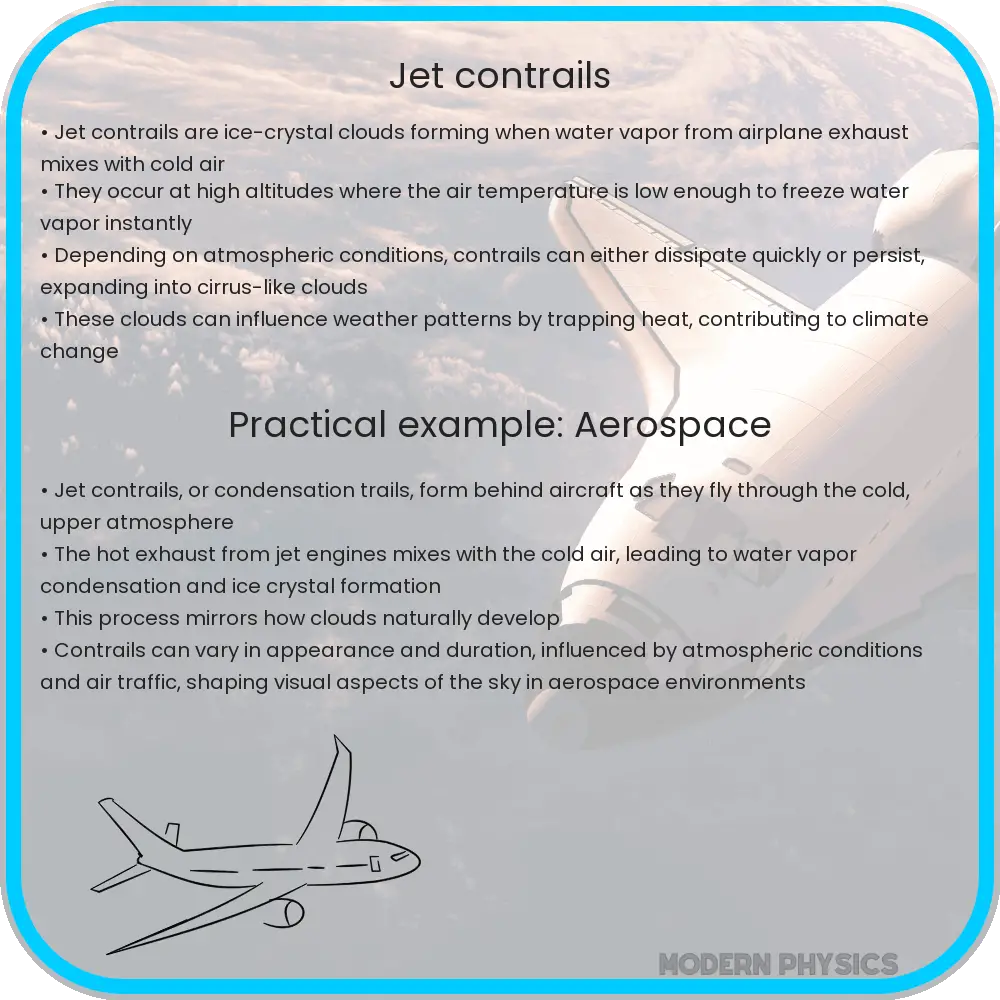Understanding the formation of jet contrails and their impact on the climate as produced by aircraft exhaust interacting with the atmosphere.

Understanding Jet Contrails: Formation and Climate Impact
When you look up at the sky and see those white streaks trailing from jets, you’re observing a phenomenon known as jet contrails, or condensation trails. Contrails form when the hot humid exhaust from jet engines meets the regions of lower pressure and temperature in the atmosphere. The science behind these seemingly simple streaks of cloud is not only interesting but also increasingly relevant to our understanding of climate change.
How Do Jet Contrails Form?
The formation of jet contrails is closely linked to atmospheric conditions and the nature of aircraft exhaust. Essentially, contrails occur because aircraft engines emit water vapor, carbon dioxide, soot, and other particulates. As a jet flies high in the troposphere or lower stratosphere, its engines expel hot, humid air into the ambient cold environment, prompting the water vapor to condense onto the existing particles from the engine. As the water vapor condenses, it forms tiny water droplets or ice crystals (depending on the atmospheric temperature), which are visible as clouds trailing the aircraft.
This process can be illustrated simply by the equation for water condensation:
\[ H_2O\_(g) + (cooling) \rightarrow H_2O\_(l) * or * H_2O\_(s) \]
Where \(H_2O\_(g)\) represents water vapor, \(H_2O\_(l)\) is liquid water, and \(H_2O\_(s)\) represents solid ice, depending on the temperatures involved.
Types of Jet Contrails
Contrails can be classified primarily into three types based on their persistence and spreading in the sky:
- Short-lived contrails: These appear briefly and dissipate quickly because the surrounding air is minimally saturated with moisture.
- Persistent non-spreading contrails: These contrails last for a considerable amount of time but retain their narrow line shape without dispersing.
- Persistent spreading contrails: These linger and spread across the sky, forming cirrus-like cloud cover that can affect weather and climate patterns.
The Climate Impact of Jet Contrails
Contrails, particularly persistent spreading contrails, have a dual effect on the Earth’s climate. During the day, these clouds can have a cooling effect by reflecting sunlight back into space. However, at night, they act as an insulating blanket, trapping heat radiated from the Earth’s surface which would otherwise be lost to space. This trapping of heat contributes to warming—a phenomenon known as the greenhouse effect.
Studies have shown that while the cooling effect during the day might offset some of the warming at night, the overall impact, particularly with expected increases in air traffic, may lead to net climate warming. Moreover, the persistent spreading contrails contribute to the formation of cirrus clouds, which are known to have a net warming effect on the earth’s surface.
To gain a better understanding and effectively mitigate the environmental impacts, it is crucial to study contrails comprehensively. The research involves not only observing and modeling contrail formation under various atmospheric conditions but also assessing their overall influence on climate over time.
Thus, the study of jet contrails is not just about appreciating a common visual element in our sky but also understanding a critical and growing impact on our global environment.
Current Research and Mitigation Strategies
Due to the potential climate impacts of contrails, scientific research is increasingly focused on understanding how to minimize their formation and spread. One approach involves altering flight routes or altitudes in regions where contrails are likely to form persistent spreading clouds. Additionally, advances in aircraft engine technology could reduce the amount of soot particles emitted, thereby limiting the surfaces upon which ice crystals can form.
Another promising area of research is the development of alternative fuels that produce less water vapor as a byproduct of combustion. These biofuels, or synthetic fuels, might significantly reduce the formation of contrails by reducing the primary exhaust materials that contribute to their formation.
Public Awareness and Policy Making
In addition to technical solutions, increasing public awareness about the environmental impacts of contrails is crucial. Educational campaigns can inform the public and policymakers about the nuances of contrail formation and its implications for climate change. This informed awareness can drive policy decisions that support sustainable practices in aviation, such as optimizing flight paths and investing in cleaner technology and fuels.
Finding the balance between maintaining the benefits of air travel and reducing its environmental impact requires a concerted effort from governments, the aviation industry, scientists, and the public. Policies that incentivize rapid adoption of green technologies and stricter regulations on flight operations could be effective in managing contrail effects on the global climate.
Conclusion
Jet contrails are more than just transient features in the sky; they are a by-product of modern aviation that has complex effects on the environment. By understanding the types and formations of contrails, and recognizing their impact on the climate, both the public and policymakers can better address the challenges they pose. Ongoing research and innovations in flight and fuel technologies show promise for mitigating these impacts. With continued dedication to understanding and addressing this issue, it is possible to enjoy the benefits of air travel while managing its environmental footprint, ensuring both our planet’s health and the feasibility of future air travel.
In the journey towards a sustainable future, every contrail seen in the sky should serve as a reminder of the importance of scientific understanding and technological advancement in protecting our environment.
